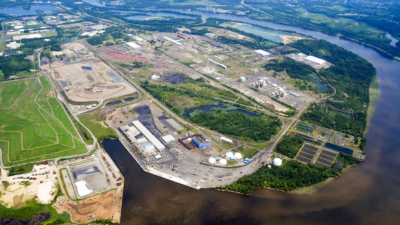U.S. occupier activity in bulk industrial space (tenant size larger than 100,000 square feet) continued to outpace 2021 transactions at the end of the third quarter. Transaction volume increased 17.9% year-over-year, yet it is showing some signs of deceleration. Year-to-date activity totaled nearly 486.5 million square feet through the third quarter, largely due to strong transaction volume momentum at the beginning of the year. In addition, almost 1,700 industrial (warehouse, manufacturing, and flex) new leases, renewals and user sales were transacted year-to-date, compared to 1,400 a year ago. Although occupier transaction volume increased, the average transaction size for bulk space was roughly 287,200 square feet, down moderately from the average size of 288,300 square feet during the same period last year.
Third-party logistics and packaging companies (3PLs) remained the top occupier of bulk industrial space during the third quarter, increasing their market share from 29.7% to 30.2% of all bulk space transacted one year ago. 3PL providers, who offer outsourced logistics and warehousing services for retailers and wholesalers, remain the top occupier of industrial space for a variety of factors, including cost savings for retailers and wholesalers and difficulty finding labor. While 3PLs were the top overall occupier, the data centers/tech/R&D industry increased its market share by 78.1% year-over-year and transacted 20.1 million square feet third quarter. The only industries to see a year-over-year decline in activity were the e-commerce industry (-20.6%) and the furniture and appliances sector (-11.4%).
 U.S. National Research
U.S. National Research
“Occupiers will continue reassessing their supply chain strategies, and outsourced distribution will become a more appealing option to some tenants. This should increase the need for bulk space for 3PL providers, while companies competing in the e-commerce space will look for new markets for expansion opportunities.”
Amazon remained the largest occupant of bulk space in the U.S. third quarter. Yet, Amazon’s occupancies declined 26.4% from this time last year, filling 43.7 million square feet this quarter compared to 59.4 million square feet transacted a year ago. Amazon’s largest occupancy was a 1.1-million-square-foot facility in York, PA – but despite its size, it was only the 8th largest occupancy during the third quarter. On the other hand, Walmart increased its occupancies year-over-year by 52.4% to capture more of the online shopping market share. Amazon remains the largest online retailer, while Walmart comes in at a distant second.
E-commerce sales are projected to grow at a healthy clip over the next five years as consumers shop online for both grocery and non-food items, leading to continued demand. Although e-commerce-only occupiers accounted for just 12.3% of all transactions in the third quarter, their average transaction size was approximately 517,300 square feet – the largest average size of any industry included in our research. Not surprisingly, Amazon has held the title of the top e-commerce company and overall occupier of industrial space since 2014.
Transactions in the Midwest accounted for 27.8% of all bulk occupier activity, followed by the West region with 25.1%. The Southcentral market was the slowest at the end of the third quarter, accounting for just 10.3% of transactions signed. The West region moved into the second spot largely due to industrial bulk activity in the Inland Empire. The Inland Empire is considered the premier big-box market in Southern California and continues to attract large distributors, warehousers, e-commerce companies and logistics firms seeking to consolidate their operations into large, state-of-the-art facilities.
Transaction volume for bulk industrial space is expected to moderate over the next 12 months as economic headwinds, including persistent inflation, rising interest rates, and falling consumer confidence, continue to build. While 3PLs continued to dominate activity year-to-date, four industries experienced increased activity by more than 40%: data centers, tech, R&D (78.1%); motor vehicles, tires, and parts (51.5%); construction, improvement and repairs (49.4%); and food, beverage, and pet supply (40.4%). We expect these industries to remain in the top spots, as many of these occupiers continue to expand and modernize their distribution and manufacturing networks.
More than 650 million square feet remained under construction at the end of the third quarter, and nearly 200 of those facilities are larger than one million square feet. Occupiers will continue reassessing their supply chain strategies, and outsourced distribution will become a more appealing option to some tenants. This should increase the need for bulk space for 3PL providers, while companies competing in the e-commerce space will look for new markets for expansion opportunities. This continued demand, coupled with record levels of industrial product under construction, will continue to offer modern options for bulk occupiers in the coming quarters.
Company Type Description:
- Construction, Improvement and Home Repair – Warehousing and distribution of materials used in residential and commercial construction, improvements and repair, could contain some e-commerce components.
- Data Centers, Tech and R&D – The use of industrial space for data centers and non-pharmaceutical R&D purposes.
- E-Commerce Only – Warehousing and distribution of product that is ordered online and shipped directly to the end consumer only.
- Food, Beverage and Pet Supply – Manufacturing, warehousing and/or distribution of food and beverage related products. Could contain some e-commerce or manufacturing components.
- Furniture and Appliances – Warehousing and distribution of retail and/or wholesale furniture and appliance products. Could contain some e-commerce and or manufacturing components.
- General Retail and Wholesale – The warehousing and distribution or retail and/or wholesale products not listed in any of the other categories. Could contain some e-commerce or manufacturing components.
- Manufacturing – Industrial space used for manufacturing and/or storage of raw materials and equipment used in the manufacturing of non-automobile related products.
- Motor Vehicles, Tires and Parts – The warehousing, manufacturing and/or distribution of motor vehicles, tires, and related parts and materials.
- Third-Party Logistics and Packaging – Third-party logistics (3PL) and packaging of a wide variety of products, could contain some e-commerce components.



 Craig Hurvitz
Craig Hurvitz
 Lauren Pace
Lauren Pace Ronna Larsen
Ronna Larsen
 Tom Golarz
Tom Golarz Michael Golarz
Michael Golarz